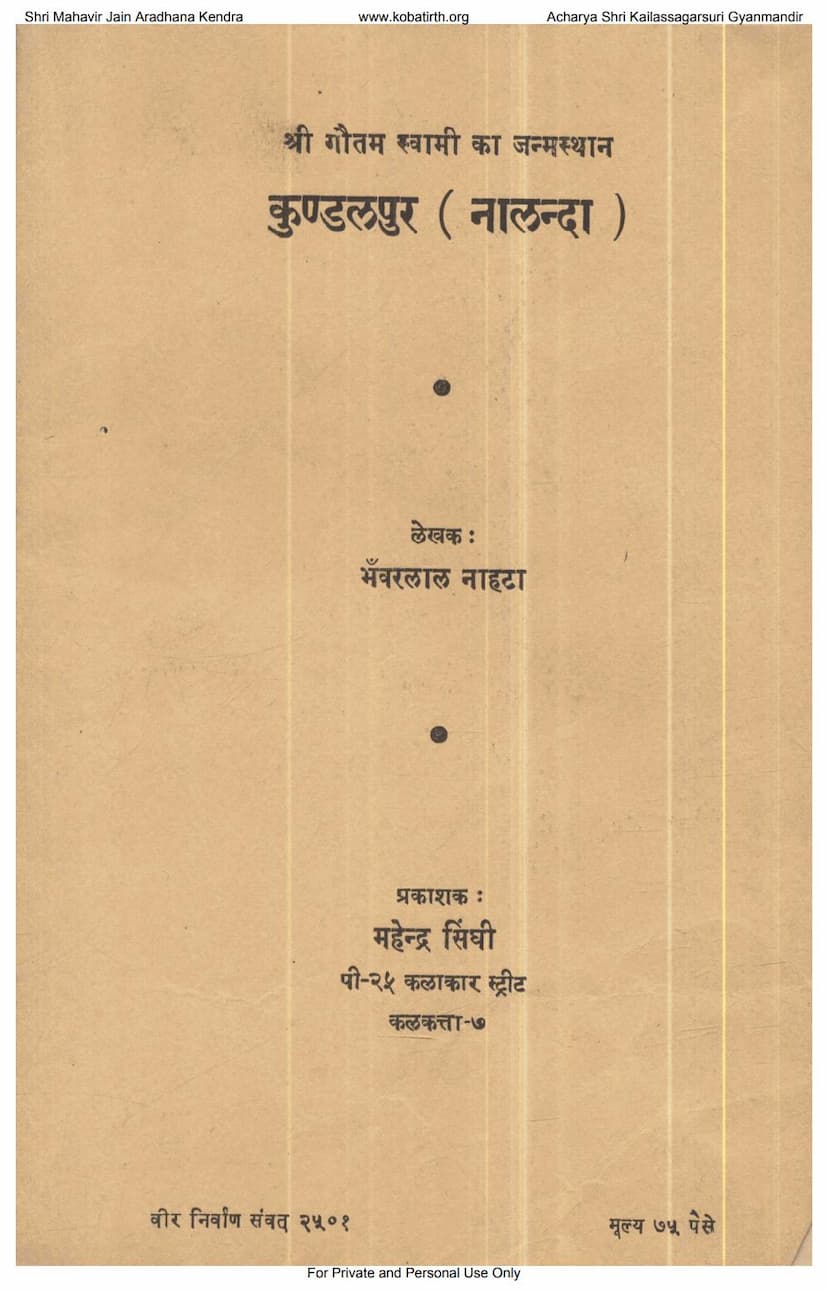Kundalpur
Added to library: September 2, 2025

Summary
Here's a comprehensive summary of the provided Jain text, "Kundalpur" by Bhanvarlal Nahta, focusing on its content and historical insights:
The book "Kundalpur" by Bhanvarlal Nahta, published by Mahendra Singhi, is a scholarly exploration of the historical and religious significance of Nalanda, a prominent ancient Indian site, with a particular focus on its deep connection to Jainism. The author, Bhanvarlal Nahta, is an esteemed scholar who has previously written on other significant Jain pilgrimage sites like Rajgir, Pawapuri, and Sametshikhar.
Core Argument and Historical Context:
The central thesis of the book is to firmly establish the Jain identity and importance of Nalanda, often overshadowed by its later association with Buddhism. Nahta argues that while modern archaeology has brought to light the renowned Nalanda University, the site has always held a place of importance in Jain scriptures and traditions. He contends that the ancient Jain settlement of Nalanda, and its associated locations like Badgaon and Gubar-gaon, were never forgotten by the Jain community.
Key Points and Evidence Presented:
-
Jain Scriptures: The book cites various Jain texts to support its claims. Notably, it mentions:
- The Sutra-kradanga Sutra, which has an entire chapter named "Nalandaijja" dedicated to Nalanda.
- The Bhagavati Sutra, which describes a settlement called Kojak near Nalanda.
- The Vividha Tirthakalpa by Jinaprabh Suri, which is presented as a crucial source identifying Nalanda as a significant Jain site.
-
Lord Mahavir and Gautam Swami: A significant emphasis is placed on the connection between Nalanda and Lord Mahavir. The text states that Lord Mahavir spent fourteen Chaturmas (monsoon retreats) in Nalanda, and it was also the birthplace of his chief Ganadhara (disciple), Indrabhuti Gautam Swami. The book highlights that the Gautam Swami Astak by Mahopadhyay Samaysundar Gani is included in the text, detailing Gautam Swami's life and virtues.
-
Nalanda's Jain Identity:
- Nahta argues that the Jain population in Nalanda during Lord Mahavir's time was substantial, numbering "twelve and a half crore Jains."
- He points out that Lord Buddha also visited Nalanda and resided in the Pravarika Mango Grove, but it was Lord Mahavir who spent fourteen Chaturmas there, suggesting a strong Jain presence and dominance at the time.
- The text mentions that while Buddhist scriptures often depict discussions between Lord Buddha and Nirgranthas (Jains), these are sometimes considered imaginative.
-
Gautam Swami's Birthplace and Related Sites:
- The book identifies Gubar-gaon, near Nalanda, as the birthplace of Gautam Swami. It notes that Nalanda is still referred to as Badgaon and Gubar-gaon.
- The term "Kundalpur" as the new name for this place is discussed, with the author noting its absence in ancient Jain literature and suggesting it gained prominence later, possibly due to the Digambara community identifying it as Lord Mahavir's birthplace (Kundapur/Kshatriyakundapur).
-
Historical Evolution and Archaeological Discoveries:
- The author acknowledges the archaeological excavation of Nalanda University in the last 60 years, which brought international fame to the site.
- He mentions the discovery of Jain stūpas, such as the "Kalyanak Stupa" mentioned by Jinaprabh Suri, distinct from the Buddhist stūpas built by Ashoka or the eight kings after Buddha's Mahaparinirvana.
- The text traces the history of Nalanda from its early Jain significance through the Gupta period when the university was established and flourished under various rulers like Kumaragupta, Harshavardhana, Yashovarman, and the Pal rulers.
- It describes the destruction of Nalanda University by Bakhtiyar Khilji in the 12th century, the subsequent period of neglect, and the rediscovery through archaeological excavations in the 20th century.
-
Jain Monuments and Practices:
- The book details the presence of Jain temples and idols in Nalanda over centuries, citing various pilgrimage accounts (Tirthmalas) from different periods.
- It mentions the worship of Gautam Swami's footprints (paduka) at a Kalyan Stupa, which was considered a significant pilgrimage spot.
- Several inscriptions and mentions from pilgrimage accounts (like those by Hanssom, Punyasagar, Jayavijay, Jaskirti, Vinaysagar, Saubhagya Vijay, Shail Vijay, and Vijay Sagar) are presented, highlighting the continued presence of Jain worship and structures.
- The book discusses specific idols and temples, including the Adinathtaji idol from 1477 AD and a Mahavir Swami idol from 1504 AD, and mentions ancient inscriptions found in the area.
-
Calls for Preservation and Development:
- The author stresses the importance of repairing the existing dilapidated Jain Dharamshala (rest house).
- He advocates for the establishment of a hostel or student accommodation to benefit from the Nalanda Institute.
- The need for a proper paved road to the ancient temple and clear signage is highlighted to help visitors and pilgrims.
Key Contributors and Sources:
The author acknowledges the contributions of various scholars and patrons, including his friend Dr. Nathmalji Tatia, and the publisher Mahendra Singhi, who has undertaken the project of publishing illustrated works on Jain pilgrimage sites. He also mentions the work of Acharya Anantprasad Jain and Western scholars in identifying the ruins of Nalanda.
In summary, "Kundalpur" by Bhanvarlal Nahta is a meticulously researched work that aims to reclaim and highlight the significant Jain heritage of Nalanda. It provides substantial textual and historical evidence to establish Nalanda as a vital center for Jainism, particularly in relation to Lord Mahavir and Gautam Swami, predating its later fame as a Buddhist university. The book serves as a crucial resource for understanding the multi-religious history of ancient India from a Jain perspective and calls for the preservation and promotion of its Jain legacy.